Article
Transforming HR workflows with AI

“The biggest barrier to AI adoption isn’t technology — it’s the inertia of the status quo.”
When Turing CEO, Jonathan Siddharth, said that Turing needed to onboard 800 new people in the span of a single week, I told him we would “AI our way out of this.” Looking back, this was the beginning of truly scaling HR operations with AI, not just to meet the immediate demands but to lay the foundation for creating an AI-forward culture. Below are five ways Google Workspace has embraced this moment of HR transformation with AI.
1. Onboarding talent at scale with the help of AI
In early 2024, Turing needed to hire and train people more quickly to meet the demand for our services. That was when we designed Turing University, powered by AI, to route talent to multiple onboarding paths based on role, skill set, and the required speed of deployment. It’s a bit like the London Underground — multiple lines run under one central system.
To build this system, we created videos of engineering leaders onboarding new talent, used those videos to train a proprietary LLM, and then our model generated interactive learning modules for new hires. These included work simulations, sandbox environments for hands-on practice, and knowledge assessments for both formal exams and proficiency checks.
The new onboarding program took just three hours to create instead of the 2-5 weeks we used to spend putting this type of program together. Thanks to these AI-driven innovations, Turing onboarded over 5,000 people in the second half of 2024.
2. Empowering our talent with Gems
Gems are customized versions of Gemini that you can tailor to specific types of tasks, like coding, deep research, or data analysis. We’ve developed multiple career-focused AI assistants tailored to specific technical roles, which help upskill and validate technical proficiency for hundreds of team members.
For broader impact, in our Thrive Together program, Google Workspace launched Google’s premade Gemini Career Builder Gem, which delivers highly personalized career guidance, motivation, and learning support. We paired it with training on how to use the Gem effectively, and alongside Turing’s curated library of self-paced technical courses, the Gem empowers team members to grow their skills in measurable ways without increasing HR headcount.

Thrive Together Gem delivers highly personalized career guidance and learning support.
3. Optimizing training programs
Turing AI agnostic, so we always select the best AI tool for the job. To help us improve, Turing built a Gem to analyze feedback on how the training modules were working.
Turing discovered that some of our talent, which is spread around the globe, found it difficult to understand the accents of their trainers. That insight led us to embrace synthetic voices. With synthetic voices, Turing can create audio tracks with different accents, languages, and even dialects for each region. Now we can change the script, click publish, and launch the updated module in a matter of minutes.
4. Retaining talent
With the release of Gemini 2.5, Turing been able to better personalize employee development programs and streamline staffing workflows. And the embedded experience within Google Workspace has helped increase adoption and daily usage among team members — from Gmail to Sheets.
All of these aspects contribute to higher employee satisfaction and retention. Team member satisfaction rose 32% in the first half of this year, setting a company record. Our top-scoring drivers: Turing University and manager effectiveness.
5. Automating HR support
Turing people ops team saw support ticket volumes surge from 5,000 to 18,000 per quarter after 4,000 new team members joined in six months. Existing workflows broke down under the strain of such hypergrowth.
During a two-day hackathon, Turing team developed and launched a new AI model. The model was trained on internal knowledge to draft replies, which were then reviewed by our staff. This preserved oversight while speeding response times and supporting alignment with our policies and culture.
After only two working days of development, the custom model reduced ticket processing time by 33%. Since then, Turing built Gems that are on track to automate 60% of the 52,000 annual tickets by year end. That frees up the rest of our team to create agentic workflows that automate other key HR tasks.
Creating an AI-forward culture
All of these technology implementations created new efficiencies for HR operations. But the biggest barrier to AI adoption isn’t technology — it’s the inertia of the status quo. As an AI-native HR executive, I have two roles when it comes to AI: boosting workforce productivity and creating an AI-forward culture.
That’s why Turing people ops specialists receive targeted training to understand how AI can augment — not replace — their expertise. That gives them the confidence to lead this transformation. It’s critical for AI and human intelligence to work alongside each other. AI tools should complement, not replace, the work and expertise of an HR team. Having an “informed human in the loop” is at the foundation of our long-term plans for transforming HR workflows with AI.
Related News

Built with BigQuery: How Oden provides actionable recommendations with network resiliency to optimize manufacturing processes
See Detail
Fast Migration Process using Google Cloud
See Detail
Use Your Favorite DevOps and Security Solutions with GKE Autopilot Out of The Box
See Detail